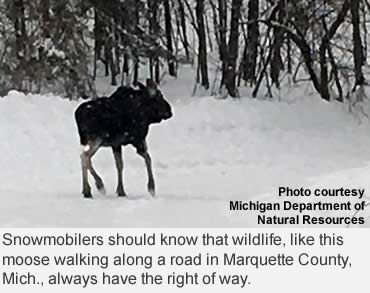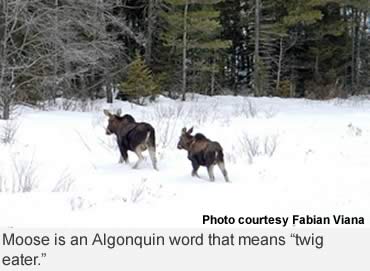Photo: Where is the best place to see a moose? NOT on a snowmobile trail.
Where winter clings to the landscape with heavy snowfalls, in places like Michigan’s Upper Peninsula, snowmobiling is great fun. But that’s not the reason moose and deer use the same trails as snowmobilers.
“The deep snow can make using the packed snowmobile trails and roads attractive to wildlife, particularly deer and moose, because using trails makes it much easier for them to move,” says Brian Roell, a wildlife biologist with the Department of Natural Resources.
“We’re getting reports from across the Upper Peninsula about deer and moose not wanting to leave the roadways or trails,” he said. “Moose will use trails to avoid the deeper snow. If snowmobilers encounter a moose while riding, they should observe it from a distance and not chase the animal.”
There’s another reason Roell advises snowmobilers to avoid moose if they see one on a trail.
Moose are not frightened by snowmobiles or other vehicles.
“Moose may stand their ground and refuse to leave the trail, and could become aggressive,” he said. “Trail users encountering a moose on the trail should pick an alternate route or wait for the moose to move out of the trail before proceeding.”
 One more warning. Riders should never approach a moose.
One more warning. Riders should never approach a moose.
“If the animal shows interest by slowly walking toward you, or has it ears laid backward or the hairs on its back raised, put some space between you and the moose by backing up or turning around and leaving the area,” Roell advises. “There are fines for harassing wildlife. It’s best to remember wildlife always has the right of way.”
Moose are the largest members of the deer family, and they are also the tallest mammals in North America. From shoulder to hoof, they are between 5 and 6 1/2 feet tall, and tip the scales between 725 to 1,100 pounds.
It’s no wonder they are not frightened by snowmobiles or other vehicles.
They have short tails, a hump on their muscular shoulders, and large ears that rotate to give them stereophonic hearing. Male moose have massive antlers that can grow 6 feet wide from tip to tip, and are shed each winter after mating season.
Moose is an Algonquin name that means "twig eater,” which is appropriate. In the wild, they graze on leaves, bark, pine cones, twigs and buds of trees and shrubs as well as aquatic plants.
 They are excellent swimmers and can run close to 35 miles an hour over short distances, and trot at 20 miles an hour for longer periods, with their wide hooves acting like built-in snowshoes. Their keen hearing and well-developed sense of smell helps make up for poor vision.
They are excellent swimmers and can run close to 35 miles an hour over short distances, and trot at 20 miles an hour for longer periods, with their wide hooves acting like built-in snowshoes. Their keen hearing and well-developed sense of smell helps make up for poor vision.
Moose are a native species to Michigan, although by the late 1800s, they had disappeared from Michigan’s Lower Peninsula and only a few remained in the Upper Peninsula.
In the 1980s, the Department of Natural Resources translocated 59 moose from the Algonquin Provincial Park in Ontario, Canada and released them in Marquette County.
The moose reintroduction resulted in producing a self-sustaining population of free ranging moose in Marquette, Baraga and Iron counties, with a smaller remnant population present in Alger, Schoolcraft, Luce and Chippewa counties.
Michigan is not the only cold-weather state with a moose population.
Only areas that have seasonal snow cover are places moose call home. They cannot tolerate temperatures above 80 degrees because they cannot sweat.
Fourteen other states have moose: Maine, New Hampshire, New York, Vermont, Wisconsin, Minnesota, North Dakota, Utah, Colorado, Montana, Wyoming, Idaho, Washington and, of course, Alaska.
Approximately 1 million moose live in Canada’s provinces and territories of British Columbia, Alberta, Saskatchewan, Manitoba, Ontario, Quebec, Nova Scotia, New Brunswick, Newfoundland and Labrador and the Yukon, Nunavut and Northwest Territories.
You can find more information about moose here, here and here.
– Resources: Michigan Department of Natural Resources, Moose World, Live Science.